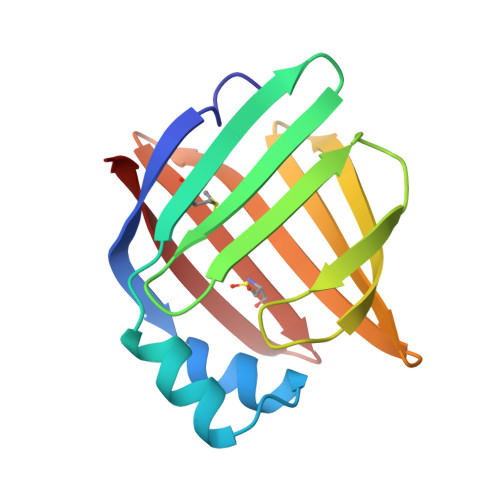Adipocyte lipid-binding protein complexed with arachidonic acid. Titration calorimetry and X-ray crystallographic studies.
LaLonde, J.M., Levenson, M.A., Roe, J.J., Bernlohr, D.A., Banaszak, L.J.(1994) J Biol Chem 269: 25339-25347
- PubMed: 7929228
- DOI: https://doi.org/10.2210/pdb1adl/pdb
- Primary Citation of Related Structures:
1ADL - PubMed Abstract:
The association of the adipocyte lipid-binding protein (ALBP) with arachidonic acid (all cis, 20:4 delta 5,8,11,14) and oleic acid (cis, 18:1 delta 9) has been examined by titration calorimentry. In addition, the crystal structure of ALBP with bound arachidonic acid has also been obtained. Crystallographic analysis of the arachidonic acid.ALBP complex along with the previously reported oleic acid-ALBP structure (Xu, Z., Bernlohr, D. A., and Banaszak, L. J. (1993) J. Biol. Chem. 268, 7874-7884) provides a framework for the molecular examination of protein-lipid association. Isothermal titration calorimetry revealed high affinity association of both unsaturated fatty acids with the protein. The calorimetric data yielded the following thermodynamic parameters for arachidonic acid: Kd = 4.4 microM, n = 0.8, delta G = -7370 cal/mol, delta H = -6770 cal/mol, and T delta S = +600 cal/mol. For oleic acid, the thermodynamic parameters were Kd = 2.4 microM, n = 0.9, delta G = -7770 cal/mol, delta H = -6050 cal/mol, and T delta S = +1720 cal/mol. The identification of thermodynamically dominating enthalpic factors for both fatty acids are consistent with the crystallographic studies demonstrating the interaction of the fatty acid carboxylate with a combination of Arg106, Arg126, and Tyr128. The crystallographic refinement of the protein-arachidonate complex was carried out to 1.6 A with the resultant R factor of 0.19. Within the cavity of the crystalline binding protein, the arachidonate was found in a hairpin conformation. The conformation of the bound ligand is consistent with acceptable torsional angles and the four cis double bonds in arachidonate. These results demonstrate that arachidonate is a ligand for ALBP. They provide thermodynamic and structural data concerning the physical basis for protein-lipid interaction and suggest that intracellular lipid-binding proteins may mediate the biological effects of polyunsaturated fatty acids in vivo.
Organizational Affiliation:
Department of Biochemistry, School of Medicine, University of Minnesota, Minneapolis 55455.


















